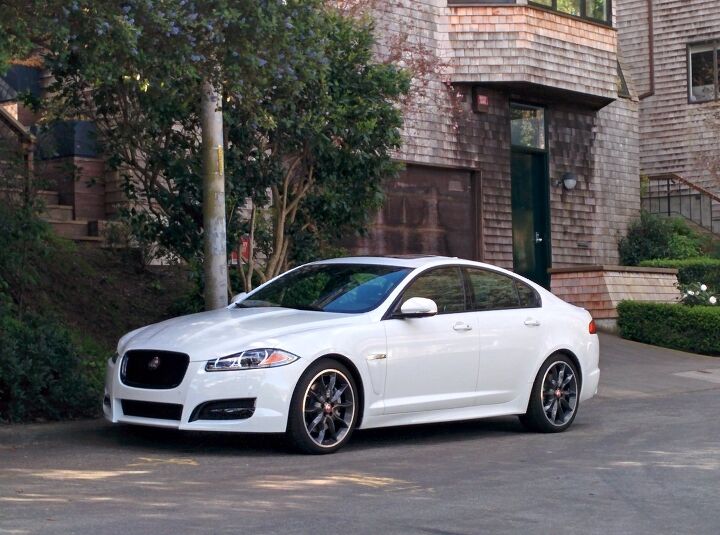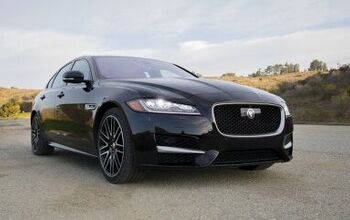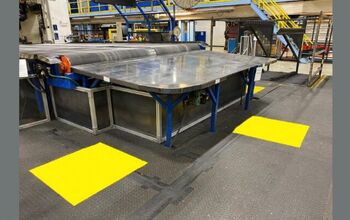Review: Jaguar XF 3.0 Sport
It seems that whenever you read a review of a Jaguar, it’s never of a model that most people buy. It generally has a supercharged V-8 which is powerful enough for law enforcement to be on a first name basis with the driver. Its exhaust is loud enough to force the homeowners’ association to call an emergency meeting. The price tag is enough to send someone to a private college for a year and a half. It would be lucky to make less trips to the gas station than Nordstrom. The maintenance costs will come to rival its owner’s property taxes. Jaguar will probably make less than 10,000 units of that model during its lifespan for the entire world.
This review of a Jaguar will be very different from one you typically read in other automotive publications. This Jaguar has a supercharged V-6 (though law enforcement may still get to know you). The price tag is enough for only one year at a private college. The neighbors will be fine with the sound it makes. The owner can afford to shop at Neiman Marcus rather than Nordstrom. Maintenance costs will probably rival its owner’s mobile phone bill. And Jaguar will sell way more than 10,000 of it around the world this year.
Such was the case when I had a Jaguar XF 3.0 Sport for a week. Rather than assuming the persona of a successful business executive who could waltz into Bloomingdale’s like it was his second home, I ended up chauffeuring my friends to their different engagements throughout Northern California. It turned out to be good for reviewing the car, but it resulted in having no time to visit any upscale shopping centers.
In other to get some scenic photos during my time with the XF, in one day I drove from San Jose to San Francisco to Stinson Beach ( it’s beautiful) to Petaluma (I got sick of seeing Tomales Bay for miles) to Sonoma (racetrack turned out to be closed) to Calistoga (the speedway there turned into a construction site and was repurposed into a baseball field) to Napa (where there’s really good food) and then back to San Francisco. In the process, I put at least 250 miles in one day on the car. During that trip, I learned many things about the car, both good and bad.
The powertrain, with its 3-liter supercharged V-6 which makes 340 horsepower with the ZF 8-speed gearbox, was excellent. Jaguar advertises that the car can go from 0-60 miles per hour in under six seconds and I believe them. When I needed to pass some slow-moving trucks on a two-lane road, the powertrain had no trouble dropping down a few gears and delivering the necessary power to get past quickly. Personally, getting an XF with the 5-liter V-8 is unnecessary in my opinion. As for handling, during the jaunt from San Francisco to Stinson Beach, there were plenty of winding roads. So I put the XF in dynamic mode, put the transmission in sport mode, and the Jaguar promptly made its point about why there are W-rated tires fitted to it. In other words, it’s very good. During my time with the car, the XF returned an average of 23 mpg, which came right in line with the EPA estimates. There’s also a start-stop system on it which perhaps helped that number.
People loved the looks of the XF, especially the white with black wheels color combination of my test car. Ever since the XF’s facelift for the 2012 model year, the design has become totally timeless. When driving it through San Francisco and Berkeley, people on the sidewalk felt the need to look at the car. Moreover, in a totally unscientific experiment, I parked it in my driveway (in place of my E39 530i) and observed how many people looked the car as they drove by. Almost every time, the driver always felt the need to get a better look at the car. When the car went away, most of my neighbors did a double take at the press vehicle that replaced the Jaguar. (I’m pretty sure my neighbors are thinking the XF is in the shop at the moment.) Furthermore, other drivers tended to move over for the Jag when I was driving up Highway 1.
However, I came across some parts of the car I didn’t like. There’s no way I can sugarcoat this, but the user interface is awful. It’s the only aspect of the car which gives you an inkling that the XF dates back from 2008. I like to make fun of the difficulty of using BMW’s iDrive, but after using iDrive in my dad’s X3, it’s become surprisingly intuitive. Meanwhile, the touchscreen system in the XF’s dashboard is slow, and it takes an eternity to scan through different radio stations. The navigation system doesn’t have the level of sophistication as systems from other manufacturers, giving me a fairly roundabout way to get from San Francisco to Berkeley. The same touchscreen system has to be used to work the climate control. To switch on the seat heaters, you have to press the seat button on the dashboard, and then select the level of heat you want on the dashboard. On the bright side, streaming music from an iPhone 6 using Bluetooth worked out well, while the base Meridian sound system sounds good too.
Since I was driving multiple people when I had the car, I got plenty of feedback regarding the interior. The at-least 12-way front sport seats weren’t liked by everyone, especially since you can’t simply slide into them due to the bolstering. (I wouldn’t recommend them if you’re over 200 pounds.) No one complained about rear seat comfort; I heard no complaints after sitting there for two hours. Folding down the rear seats to fit more cargo is another unorthodox process. You have to open the trunk, pull a lever located on the trunk’s ceiling, and then pull the rear seats down. The opening created isn’t large; it’s best for objects such as skis and narrow suitcases. But most potential XF owners won’t care about that as they’ll probably have another car for that job.
While driving the car, I was constantly on edge that the poor condition of some Northern California roads and highways would put too much strain on the Jaguar’s W-rated tires on 20-inch wheels. Thankfully, a spare tire is included with the XF 3.0 Sport, though it isn’t full-size. Additionally, when fueling the car (with premium, of course), the gas pump tends to shut off after ten seconds, though the fuel tank is nowhere near full. This was a problem at the two gas stations I filled up at. I ended up researching the problem and it’s fairly common. The suggested solution was to not push the nozzle all the way in, but I didn’t have an opportunity to attempt that particular solution.
The XF 3.0 Sport is perfect for the person who always wanted an XFR, but didn’t want to deal with its cost of ownership. After all, the fuel, maintenance, depreciation, and insurance costs seriously add up. The V-6 has three-quarters of the performance of the 5-liter V-8 while getting reasonable gas mileage. Additionally, when I had the XF 3.0 Sport, most people mistook it for the XFR largely due to the body kit, the standard Black Pack with its black grille and other exterior trim bits, and the dark grey 20-inch wheels that were at one point an option on the XFR.
On the other hand, if I were to get an XF, since I’m not one for getting the sport package, I would take the XF 3.0 Portfolio at the same price, as it’s the better choice for both long distance cruising and idling in traffic, with its 19-inch wheels, has the better Meridian sound system standard (825 watts vs. the 380 in my Sport test car), and has more comfortable active heated and cooled seats included. However, other people won’t give the Portfolio without the black and dark grey trim bits the same looks as the Sport, but eventually it comes down to personal preference.
At an MSRP of $58,100, the XF 3.0 Sport is squarely in the price range of the BMW 535i, Mercedes E350, Audi A6 3.0T (which also has a supercharged V-6), and Lexus GS350. However, you can typically negotiate $3,000 to $4,000 off MSRP (sometimes even $5,000 if Jaguar USA is providing incentives too) on the XF 3.0 Sport or Portfolio, which sweetens the case for an XF. All told, you can get an XF out of the dealership’s doors for under $60,000, while having more features than a similarly priced Mercedes or Audi.
In the end, the XF 3.0 is an excellent choice if you’ve always wanted the Jaguar experience but were afraid of the ownership costs. It’s very fast while returning well over 20 miles per gallon. Onlookers will think your XF is vastly more expensive than it really is. Homeowners’ associations across the country won’t give you a hard time if you own one. And most importantly, in a neighborhood of Mercedes E-Classes and BMW 5-Series cars, people take notice of the person with an XF in the driveway. Just be aware your conversations will be longer than before. Some people can go on and on about Nordstrom.
Satish Kondapavulur is a writer for Clunkerture, where about a fifth of the articles are about old cars and where his one-time LeMons racing dreams came to an end, once he realized it was impossible to run a Ferrari Mondial. His past weekend involved seven different conversations with his neighbors about why the XF was gone.
More by Satish Kondapavulur
Latest Car Reviews
Read moreLatest Product Reviews
Read moreRecent Comments
- Teddyc73 Oh look dull grey with black wheels. How original.
- Teddyc73 "Matte paint looks good on this car." No it doesn't. It doesn't look good on any car. From the Nissan Versa I rented all the up to this monstrosity. This paint trend needs to die before out roads are awash with grey vehicles with black wheels. Why are people such lemmings lacking in individuality? Come on people, embrace color.
- Flashindapan Will I miss the Malibu, no. Will I miss one less midsize sedan that’s comfortable, reliable and reasonably priced, yes.
- Theflyersfan I used to love the 7-series. One of those aspirational luxury cars. And then I parked right next to one of the new ones just over the weekend. And that love went away. Honestly, if this is what the Chinese market thinks is luxury, let them have it. Because, and I'll be reserved here, this is one butt-ugly, mutha f'n, unholy trainwreck of a design. There has to be an excellent car under all of the grotesque and overdone bodywork. What were they thinking? Luxury is a feeling. It's the soft leather seats. It's the solid door thunk. It's groundbreaking engineering (that hopefully holds up.) It's a presence that oozes "I have arrived," not screaming "LOOK AT ME EVERYONE!!!" The latter is the yahoo who just won $1,000,000 off of a scratch-off and blows it on extra chrome and a dozen light bars on a new F150. It isn't six feet of screens, a dozen suspension settings that don't feel right, and no steering feel. It also isn't a design that is going to be so dated looking in five years that no one is going to want to touch it. Didn't BMW learn anything from the Bangle-butt backlash of 2002?
- Theflyersfan Honda, Toyota, Nissan, Hyundai, and Kia still don't seem to have a problem moving sedans off of the lot. I also see more than a few new 3-series, C-classes and A4s as well showing the Germans can sell the expensive ones. Sales might be down compared to 10-15 years ago, but hundreds of thousands of sales in the US alone isn't anything to sneeze at. What we've had is the thinning of the herd. The crap sedans have exited stage left. And GM has let the Malibu sit and rot on the vine for so long that this was bound to happen. And it bears repeating - auto trends go in cycles. Many times the cars purchased by the next generation aren't the ones their parents and grandparents bought. Who's to say that in 10 years, CUVs are going to be seen at that generation's minivans and no one wants to touch them? The Japanese and Koreans will welcome those buyers back to their full lineups while GM, Ford, and whatever remains of what was Chrysler/Dodge will be back in front of Congress pleading poverty.













































Comments
Join the conversation
Let's not forget that the XF rides on the same Ford platform developed in the 90s and used on the Lincoln LS and retro-tastic Thunderbird from the early 2000s (as well as the XF predecessor S-Type). Amazing what Jaguar's been able to do with it, all things considered.
Would the Equalizer own one, that's what I want to know.